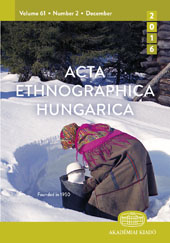Social Traumas, Community Building, Ecological Thinking, Solidarity. The Social Functions of the Hungarian Open Air Museum
Social Traumas, Community Building, Ecological Thinking, Solidarity. The Social Functions of the Hungarian Open Air Museum
Author(s): Zsolt SáriSubject(s): Cultural history, Museology & Heritage Studies, Cultural Anthropology / Ethnology, Social development, Sociology of Culture
Published by: Akadémiai Kiadó
Keywords: new museology; Hungarian Open Air Museum; social museum; community; social traumas;
Summary/Abstract: New museology, emerging in the 1970s, reached critical museology in the early 2000s. A few peculiar examples of participatory museology can be found when looking back to decades of tradition at the Skanzen Hungarian Open Air Museum. It was a long transformation from an essentially architectural museum into a social museum. In my paper I reflect on some examples of this history. Open air museums represent one of the most popular and sought-after museum types in the world, with significant ethnographic and historical collections, visitor-friendly exhibitions, and a wide range of programs related to these exhibitions. It is a common phenomenon in the museum world that social problems and sensitive issues first appear in education programs, then in research and collection strategy, and finally in exhibition politics. And so it was at the Skanzen. The tendency began in the early 21st century, when, connected to the Trianon syndrome, it materialized in the research related to the preparation of the Transylvanian building complex, then to the social traumas of 20th-century peasant society. The minority existence, being a Hungarian outside the country’s borders, is a cornerstone of the interpretation of the Transylvanian building complex. The analysis of 20th-century changes and research and collections related to the yet-to-be-built 20th-century rural building complex touched upon the history of the disappearance of peasant society as well.
Journal: Acta Ethnographica Hungarica
- Issue Year: 61/2016
- Issue No: 2
- Page Range: 419-430
- Page Count: 12
- Language: English
- Content File-PDF

